One of the biggest myths about colour analysis is that you are a season. You’re not. Let’s flip it around: there is a seasonal palette that fits you best.
There may be a seasonal palette that suits you best, but your entire identity doesn’t live and die by whether you’re a Summer, Autumn, or Winter.
This is one of the most common mindset traps I see women fall into. Colour analysis is rooted in colour theory, yes — but at its core, it’s fashion. It’s art. It’s human beings creating systems to make sense of what we see. The seasonal colour palettes weren’t designed by scientists; they were designed by people as a guide. And like any guide, it’s meant to help, not to dictate.
That’s where things often go sideways. I’ve worked with women who’ve spent hundreds (sometimes thousands) of dollars on multiple analyses, chasing the “perfect” answer. They want certainty and a clear, final label. But the harder you chase it, the more confusing it becomes — because the truth is, there is no bottom to get to. Colour analysis isn’t exact. It’s interpretation.
Why one palette won’t feel perfect
Even if we zoom into just one season, say Summer, there’s a wide spectrum within it. Two women may both “belong” to Summer, but one has deeper features and the other is lighter, more delicate. Same palette, different best colours.
That’s why it’s unrealistic to expect every single colour in your palette to be a home run. The majority will harmonize with your features, but a few may fall flat. That doesn’t mean your analysis was “wrong.” It means you’re human with a diverse set of different coloured features between your hair, skin, eyebrows, eyes and lips.
Where personal preference fits in
This is the part that often gets skipped in rigid approaches: how you feel in the colours matters. You might technically look fine in a dusty rose or a warm olive, but if those shades drain your energy or don’t feel like “you,” that’s valid. Colour psychology is absolutely a thing, as is our individual sense of self-image. I see this a lot when certain colour analysis terms are thrown around, but with a different definition depending on the person. For example - a colour that may make you feel “washed out” may actually be balanced from a colour analysis standpoint, but to your eyes it appears too dull or falls flat.
Fashion is a form of self-expression. Confidence doesn’t come from wearing the “right” colour on paper. It comes from stepping out the door feeling aligned — like your outfit reflects who you actually are.
So, what do you do if your palette doesn’t feel right?
You’ve got a few options, and none of them involve starting over or beating yourself up.
Option 1: Throw the rules out.
This may sound odd coming from someone who offers colour analysis, but hear me out. Colour analysis is not for everyone. Some women are naturally confident in choosing colours they love and don’t want to follow a framework. This might feel highly uncomfortable if you’re someone that loves structure and order. But think of it this way - you have to make a system work for you rather than making yourself work for a system. If the answer doesn’t seem clear and causes more confusion than clarity - this might be your sign to take a break from seasons and focus more on colour exploration.
Option 2: Find the overlap.
For most people, the sweet spot is in the middle. Pull the colours from your seasonal palette that truly light you up, then mix in the ones you love regardless of whether they “belong.” This gives you a custom palette — one that still honours the harmony of colour theory but doesn’t ignore your taste and intuition.
A final reminder
Colour analysis should feel freeing, not frustrating. It’s a tool to help you see patterns, shop more intentionally, and maybe expand into colours you’d never tried before.
But if it’s causing you to spiral, get caught up in undertones, or question your self-image, it’s time to step back. There’s deeper work to be done that has nothing to do with finding the “perfect” shade of blue.
At the end of the day, the best palette isn’t the one that fits a textbook. It’s the one that makes you feel excited to get dressed, empowered to experiment, and confident in your own skin.
✨ If this sounds like where you’re at, try this simple exercise: pull out the five colours from your palette that feel like an eff yes, and add five colours from your closet you love wearing no matter what. Congratulations — you’ve just built the foundation of your personal colour story.



